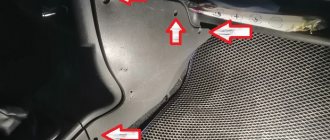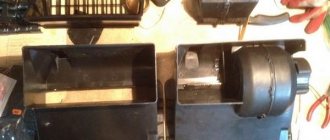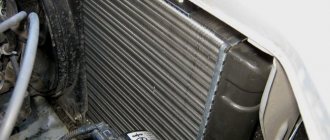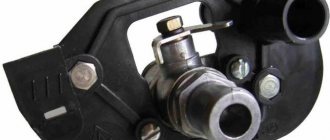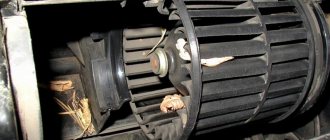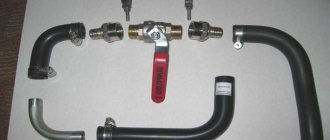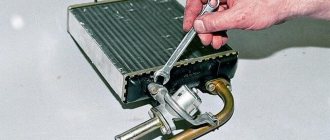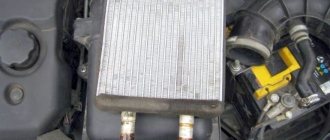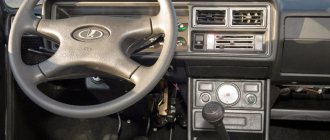Operating principle and design of the VAZ-2115 heating system
If the heater in the car does not work, especially in the cold season, there is a possibility of being left without a means of transportation, since in the cold you can simply freeze inside the car. In severe frosts, it is very difficult to clear the windshield of ice to ensure visibility, and with a non-working stove this becomes doubly problematic. You may not even be able to get to a service station.
But most often, if you know the operating principle, circuit and design of the VAZ-2115 stove, you can solve the problem on the spot yourself.
see also
Comments 213
I solved the problem by setting the thermostat to 87 degrees, the car became very warm, and I unfastened the faucet adjustment, leaving the faucet in the open position, I regulate the temperature only with the GH lever that you fixed.
Good evening. One of these days I will have to install a thermostat on Grants, and I will also have to turn off the tap. What is the situation with adjusting the air temperature? I bought a gearmotor from tens for the hot-cold damper. I want to plug the central air ducts
And after replacing the heater radiator, the airflow in my legs worsened, before it blew heat everywhere, now it blows heat everywhere but not in my legs, as you indicated, I did a cable and nothing
Yes, I'm sick of these 9-stove stoves, G completely warm, I always did everything, and the copper radiator and thermostat from 10 and closed the damper. In short, someone like me is full of crap until I installed the Opel stove with normal pipes and a torpedo And Schaaa I still I installed the heater from the 9 and their torpedoes are squeaky, but not to life
Unfortunately, this cannot always help; the heater radiator - copper or aluminum - plays a very important role. The aluminum is complete crap, (price is about 350-400 rubles) I installed a new one after completely cleaning and gluing the stove, the result was frozen sides and from the middle to the top of the windshield, I had to scratch it with my nails to get home. Afterwards I decided to splurge and bought a copper one (1400 rubles), although I didn’t immediately believe that it would be any good, but I was very mistaken! The difference is huge: 5-6 times the copper one justifies itself. And one more thing about the GC damper. If you turn the stove towards you and pay attention to the gaps of the GC damper at the ends (i.e. on the right and left sides, through the central air duct), then you will see just GAPs there! That's why some people have cold air coming into the side deflectors while the forehead of the leg and the center are warm. And even if you pull the damper with very great force, it will not help you much.
Construction of the VAZ-2115 heating system
The electrical diagram of the VAZ heater operation is represented by the following elements:
- Electric motor with fan. The fan drives hot air into the car interior and onto the windshield.
- Buttons and levers for switching heat level and air flow speed. The VAZ-2115 has 3 options for heat flow rates that can be adjusted.
- Additional resistances that provide the required rotation speed of the stove fan (step-down tungsten turn coils).
- Fuses and connection wires.
The diagram of the VAZ-2115 stove presented below clearly shows its operating structure and components.
Heater dampers don't work
The distribution of air flows throughout the cabin is carried out by dampers, which, in turn, are controlled using cables. When these cables fail, problems arise with directing the air flow to the windshield or to the foot area. In addition, the damper that blocks the flow of air from the street begins to work incorrectly. In this case, adjustment of the damper drives is required.
Such situations can arise even on a new car. Slightly warm air begins to flow from the lower, upper and side deflectors, and hot air begins to flow from the center console. This is due to the poor build quality. There are gaps between the joints of the air ducts and the dampers, which leads to warm air entering only from the center console and heating the panel from the inside.
The drive cable is always taut. Therefore, over time it bends, breaks off or stretches. In this case, it is necessary to adjust the damper drive, which is performed in the following order:
- In the stove, we look for a bracket with which the cable sheath is held on the heater body.
- A galvanized metal lever located on the left side is pulled back. This position corresponds to the maximum opening of the damper.
- The length of the cable is tightened and adjusted. The long lever on the lever block in the extreme right position should open the damper completely.
- After adjustment, the cable is securely fixed.
Video: stove repair using the example of a VAZ 2114
The operation of the stove is based on the following principle
The cooling and heating system works the same on almost all VAZ car models. The heater is turned on using a regulator located in the car itself; antifreeze is supplied to the radiator. Its temperature after warming up reaches more than 80 degrees. After which the fan starts working, operating at one of 3 speed modes.
The fan begins to create a directed air flow. It moves from the outside of the heating system into the interior of the car. Using control flaps, the driver selects heating zones, there are three in total: on the feet, on the windshield and in the car interior.
The key element of a car's heating system is the fan, and if it fails, the heating will be lost. Without it, hot air will not enter the cabin, and to heat the interior of the VAZ-2115, it will take not a couple of minutes, but a couple of hours.
Instructions for replacing the stove radiator
If the stove fan does not work, and the reason lies in the radiator, then you just need to change it.
Replacing the stove or replacing the heater radiator of a VAZ 2115 can be done with your own hands; to do this, follow these steps:
- First you need to disconnect the battery and unscrew the cap of the expansion tank in the engine compartment. Place a container under the drain hole and then drain all the coolant from the system. If during draining you see that the quality of the consumable material is low - it is too dirty, it contains wear products and deposits, then it is better to recycle this refrigerant. And after replacing the radiator, fill in a new one.
- Next, remove the steering column cover and turn off the hazard lights. You also need to remove the side trims on the center console - to do this, unscrew the bolts that secure them. Having done this, you can dismantle the glove box with internal components.
- Next, remove the cover covering the diagnostic connector, unscrew two more bolts and completely remove this connector from the center console. After this, you can remove the plugs from the cigarette lighter, as well as its backlight. Unscrew the screws that secure the heating control unit - remove it, after which you can remove the car radio.
- After completing these steps, unscrew seven more screws that secure the instrument panel, one of them is located on the right side, under the decorative trim.
- Using an 8mm wrench or pliers, you will need to remove the screws holding the center mount in place. When this bracket is moved to the side, the connector can be disconnected from the powertrain control unit. Then remove the bracket, and move the center console itself a little to the side if possible. If you remove the torpedo, then its subsequent installation may cause difficulties, so it is better not to touch this part. The best way to fix the console is to use a diamond-shaped jack or a simple wooden block.
- After you gain access to the radiator device, you will need to loosen the clamps securing the lines going to this device. In this case, you need to disconnect the pipes themselves only after you place a container underneath or put a rag, since some of the consumables may come out of them.
- When you remove all the hoses and the antifreeze is drained from the system, you will only need to dismantle the radiator and install a working device in its place. To remove the heater, unscrew the three screws and simply remove it from the heater body. If your stove fan does not work, then after these steps its functionality should be restored.
Photo gallery “Step-by-step replacement instructions”
Price issue
The cost of the device may vary depending on the manufacturer, store, and region of residence. On average, the cost of radiator devices ranges from 900 to 1500 rubles.
Major electrical failures of the heating system of the VAZ-2115
If no changes occur in the heating system at any position of the switch knob, then most likely the system motor is faulty (the brushes are worn out) or there is no voltage at the terminals. But also in this case there may be problems with the ignition switch or mounting block (fuse F4 has blown).
It is important for the proper operation of the car's heating system that there is no more than 3 ohms at the engine ground (installed under the hood).
If the heater works normally at maximum engine speeds, and problems arise only at low speeds, then the cause of the malfunction most likely lies in the speed switch button or additional resistors.
If you turn on the interior heating system and hear a noise and the heater is not blowing properly, this also indicates an engine problem. Malfunctions may include jamming of the impeller or armature bearings. Malfunctions can be eliminated by replacing components or, if necessary, lubricating them. But, as a rule, these actions have a short-term effect and the problem returns.
Over time, any equipment breaks down and requires repair. Therefore, the heating system is no exception here, and the least that needs to be done for preventive purposes is to at least carry out periodic visual inspections and diagnostics. Don’t forget that over time the system ages and wears out, so the older the car, the more it needs to be prepared for the heating season.
Reasons for decreased performance
Despite the simplicity of the design, problems with the VAZ-2114 stove often arise. They are mainly associated with a drop in the performance of the heating system - the stove heats the air poorly, blows cold or slightly warm air. In this case, the reasons for poor operation of the stove can be both general (warming up is weak at any control unit settings) and when operating in a certain mode, for example, at idle. Or, for example, cold air or slightly warm air blows only on the side windows, and in other modes the heating works normally.
Common reasons why the stove stops heating:
- the heater radiator is clogged or an air lock has formed in it;
- when switched to heating mode, the heater damper does not fit tightly to the body, which is why part of the air flow moves bypassing the radiator and enters the cabin cold;
- the tap does not open completely - this is one of the main reasons for a poorly heating stove;
- the formation of cracks at the joints of the housing and air ducts, which causes strong dispersion of the air flow.
It is not difficult to determine the cause of a general decrease in the efficiency of the heating system. To find out why the VAZ-2114 stove does not heat well, you need to remove the side decorative panels from the center console, and then warm up the engine and turn on the stove at maximum power. After this, we try the antifreeze supply pipe to the heater radiator up to the tap and behind it. The same heating temperature of the tube on both sides indicates that the tap is working properly and the problem lies in the radiator. If after the tap the pipe is less warmed up, the tap is jammed or does not open completely.
After this, we determine the temperature at the inlet and outlet pipes of the radiator. If the heat exchanger is not clogged and there is no plug in it, then the temperature of the outlet pipe will be lower than the inlet pipe. But if the outlet tube is cold, antifreeze does not circulate through the radiator, which indicates the formation of an air lock (airing) or clogging.
A common cause of failure of the VAZ-2114 stove is wear and play in the sliders. Because of this, even when they are moved to their extreme positions, the cables do not bring the valve and dampers to the stop (the valve remains closed, and the dampers do not block the air flow channels). This problem can be easily resolved - you need to make an adjustment and shorten the cables a little.
The problem of insufficient heating of one of the zones is associated with a violation of the damper control. This happens due to the same wear on the sliders, the cable jumping off the damper levers, the damper axes jumping out of the seats in the body, which is accompanied by clicks.
In addition to weak warming up, VAZ-2114 car owners are faced with the fact that the intensity of air flow decreases. This happens due to the dispersion of air through the cracks at the junction of the body and air ducts, clogging the latter with debris - many owners do not install cabin filters, so leaves get into the air ducts and interfere with air movement.
Problems with the stove on a VAZ 2115
The VAZ-2115 is an updated version of the earlier G8, Nine and VAZ-21099. The same characteristics are available for the three- and five-door hatchbacks VAZ-2113 and VAZ-2114. The interior heater design in these cars is the same, so if you are the owner of one of the listed models, then this article should be of interest to you.
Let us also recall that we have already discussed on our website Vodi.su the question of how to fix problems with the stove on a VAZ-2109.
The device of the interior heater of the VAZ-2115
The stove design here is standard:
- fan - it directs the air flow;
- radiator - heated antifreeze from the engine enters it for cooling, and the heat generated during this is sent to the passenger compartment;
- heater tap - when you turn on the heater, the tap opens and antifreeze begins to flow into the heater radiator;
- damper rods - used to regulate the air supply, as well as to heat the legs and windshield;
- heater resistor - serves to create additional resistance so that you can select the operating mode of the stove.
Updating the heating system (stove) - logbook Lada 2115 Comfort 2006 on DRIVE2
Hello everyone. Happy upcoming Defender of the Fatherland Day.
In general, one point in the operation of the stove bothered me: even when the lever for adjusting the supply of hot-cold air (hereinafter simply the GC lever) is in the extreme right position, cold air was constantly blowing on the front window and especially on the side windows, despite the fact that The breath was already hot at my feet.
Let's figure out why this happens:
Construction of a new type of stove VAZ 2113-15
If there is at least a small gap in the place indicated by the arrow, then cool air will blow on the windshield anyway.
You can call this a kind of miscalculation by engineers. Also, due to this design, temperature control of the flow is poorly performed. As you already know from the picture, if you move the GC lever a little, cool air will immediately blow into your face, and not diluted with hot air. I think virtually everyone has encountered this

